My good friend, Karen Pryor, was wondering if I could do her a favor. Six Red Marbles, a publisher of children’s educational books, was planning an early reader about Karen and they needed photographs of her training animals. Karen was one of the first marine mammal trainers (dolphins and killer whales, etc.) Her book, Don’t Shoot the Dog!, has transformed the world of dog training from dominant based to one that uses positive reinforcement and scientific principles. Her work with zoos has brought enrichment and gentle care to those establishments. (She is currently quite enthused with helping reptile keepers train their crocodiles!) Reaching the Animal Mind, her latest book, is a must read for anyone who interacts with animals of any species – including humans. Anyway, for the children’s book they didn’t need her training anything exotic, but something other than dogs would be good. Could the Six Red Marbles photographer and art director come here for a photoshoot? I practically shouted an enthusiastic yes.
Karen uses a technique sometimes called clicker training. The desired behavior is broken down into very small increments and each step to reach the final goal is marked with a click (usually from a hand-held noise-maker like those toy crickets from dime stores) and then immediately rewarded. It’s like playing the “hot and cold” game, but only saying “you’re getting hotter” and never discouraging with a “cold.” It’s ridiculously fun for the animals and trainers alike. Counter-intuitively, although the behavior is taught in the tiniest of steps, your get what you want far, far quicker than if you hold out for the ultimate trick. When Karen trains an animal, everyone is calm, it almost looks like nothing is happening, but then you realize that the animal has done the desired behavior and wants to know what’s next.
We started with the goats.
I think that I need to feed Caper less hay. Then, perhaps, he could sprightly jump up onto that barrel instead of do the “hang the belly” trick.
Next, Karen trained Agatha to follow the target (see the wand with the ball on the end?)
I’d warned Karen that Agatha is a very sweet, but rather placid and dim-witted bird. Karen has trained clams to open and close on cue, so she could certainly train Agatha! Still after a few minutes we switched to Florence, who was less mollusk-like and offered more behaviors, more quickly than Agatha. However, Agatha excels as a lap bird, and is ever so beautiful, and so she had her portrait taken by the photographer who was, I think, rather smitten with her.
Next, it was time to work with Lily. Lily is eight years old, and I’ve clicker-trained her since I got her as a rescue at the age of six months. I showed off a few of her behaviors, including weaving between my legs and a bow.
Then it was Karen’s turn. In less than a minute she taught Lily to leap up to the target stick.
This is the expression of a clicker-trained dog – calm, confident, happy, and ready for more.
However, Lily is a farm dog, and she took a break to chase some varmints. She has her priorities!
Clicker training can be exhausting. The animals are asked to think and be active participants in the training process. After everyone had left, the goats sat in the sun and chewed their cuds, mulling over the visit. It was quite the satisfying day.
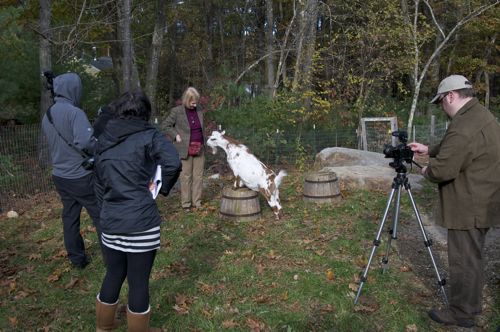
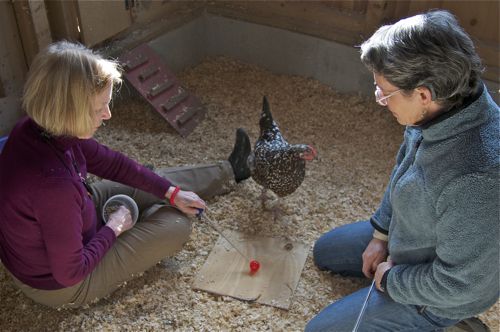
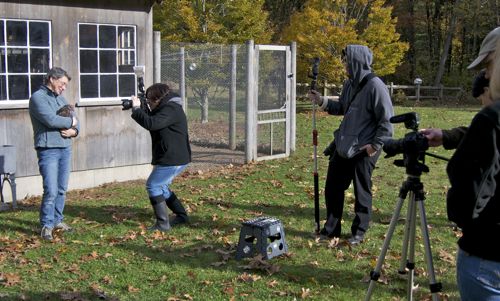
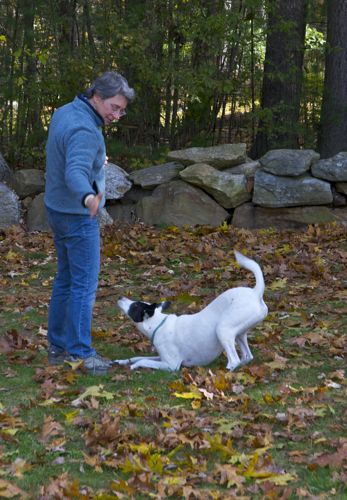
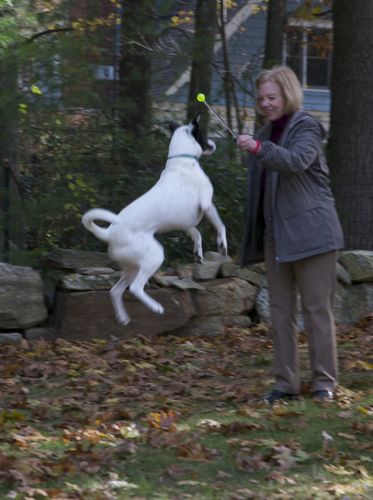
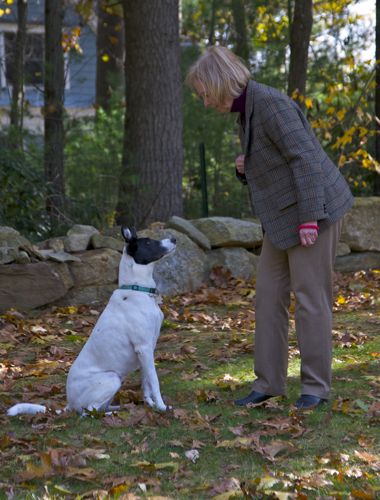
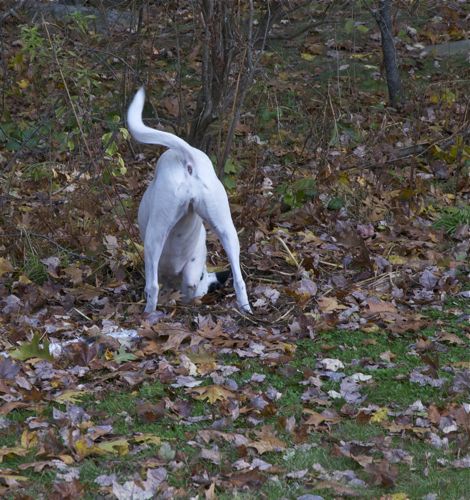
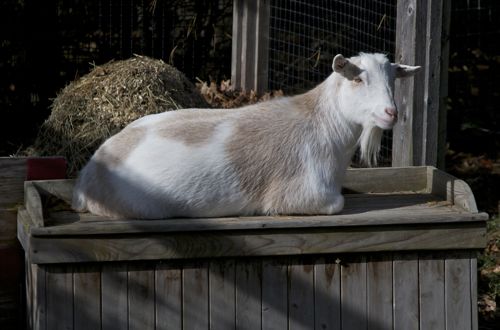
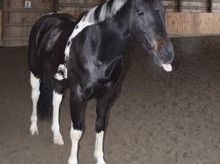
What fun.
So what did Lily chase down that hole?
Something small and mousey.
What a fun time you must have had. Just how hard was it teach Florence to follow a target. I would imagine not so easy. My hens are always on the go. Did you teach her to do more than follow the target?
Not hard at all! Amazing how single-minded a chicken will get when presented with clear criteria for earning a tiny bit of corn. We only did a 5-minute training session. But, I might teach her to stand on a “target” of a bit of duct tape, and then will transfer that to my arm…and she’ll learn to perch and stay put while I use her for school visits. I target trained all of the chickens in “Tillie Lays an Egg” and that’s how I was able to get them to pose for the book. Get the book and take a look. Every one of those photos is carefully staged although it looks quite natural!
What about Scooter?
joyce
We ran out of time to train Scooter, but they couldn’t resist taking a few photos. He has one trick in his repertoire. It’s the “look cute!” trick. Perfect every time.
Thanks, Terry, that was so much fun, and I LOVE seeing these great pictures and your story too. All the animals were splendid. Fooling around with Agatha and Florence was especially fun and Lily is really a trooper. She kept going and going and going–
by the way on her Mouse break, or possibly a Vole break, she got at least one; I saw her snatch and gulp it down, behind you.
The professional team had a great time, too; I heard from them this morning. Michele the designer said “Terry is amazing!”
KP
I missed seeing Lily gulp it down! And yet she continued to work for those little bits of freeze-dried liver afterwards. What a dog.
So nice to see the “behind the scenes” stuff! I would have loved to have been a fly on the wall! Or maybe “a goat in the pasture” would be more accurate.
Such an entertaining post as always, I really enjoyed every bit of it.
I am going to look for those books. In the meantime, can you tell me if you have to keep using the clicker, once the animal knows the trick/task, or do they do it on some kind of command or request, just on their own, afterward (also, with or without having to keep giving treats?)? If that makes sense…….
Once you get the full behavior, you put it on cue (verbal, hand signal, etc.) and you don’t have to continue to click for each tiny step – you click and treat for the final product. After that is firm, you also don’t have to continue to click and treat each time. However, always think in terms of making the training and behavior rewarding. Most people err on too few reinforcements. For example, Lily always gets something good after doing a trick. I wouldn’t expect her to work so hard without it being rewarding to her. Know your animal and know what is rewarding. Is it a scratch? A release? Food? Play? Even after getting the behavior down pat, it’s always good to do refreshers with the clicker and keep the training sharp and really fun for the animal. Training is an interchange between you and the other animal. You’re each letting the other know what you want and how to get there. Think of training as communication and it opens up a much fuller relationship with everyone around you!
I just put the Animal Mind book on my Kindle and am looking forward to reading it. Thanks!
Wonderful! Karen got her start at the marine life park in Hawaii. There’s a few stories in there about that, and much more in some of her other writings.
I can’t believe how excited this post has me!!! I’m definitely checking out her books. What a wonderful experience!
I would love to see what she could do with Candy
Unfortunately, the only reward that excites Candy are sweetened dried banana chips, and I can’t use them for training because she’d get sick if she eats too many.
I was lucky enough to stop by the HenCam while your visitors were there and got to watch them in action. I thought at first that a school class was visiting, but when I didn’t see any “short legs” I thought maybe it was a photo shoot for a new book. It was fun to watch!
Oh how I wish that Karen Pryor was my friend! I have admired her for years after I discovered “Don’t Shoot the Dog” and started clicker training my dogs. I even clicker trained a group of extra wiggly first graders to sit still.
Please tell her hello from a long time fan from Washington that has enjoyed the fun of clicker training for many years.
I have several tricks for keeping the “squirrels” sitting nicely during my storytimes. I tell them that animals like children who are calm and quiet, and if they are, they will get to pet a chicken. Later, I teach them to pet a hen as if “they are touching a cloud.” The first child who goes through the line and strokes the hen gently and lightly, I say loudly, “oh, you were listening, what a good job!” and the next child in line wants the same praise and so also pets the hen gently. Lots of praise for the behavior I want, and all that good multiplies!
Put those books on HOLD at the public library. Thanks for the suggestion!
You are very good with children and animals (and baking) and obviously have oodles of patience. Is there anything that ever throws you? What is your pet hate or phobia? You seem so unflappable and a joy to share experience with.
I am NOT fond of snakes. I confess to screaming when a harmless garter snake crosses my path in the woods.
I remember you mentioning snakes before now, Good to know there is something. My phobia is the dreaded spiders. Harmless here but look so horrible.
I always check your posts about three back for new comments, then stop looking when no more are added. Do you do the same or do you have something that lets you know when a new one is added?
Am not fond of spiders, either. Except in Charlotte’s Web.
I get a private feed of every comment. I read every one!
I love that your blog feels so interactive. I read every comment too. I really enjoy feeling a part of it and I don’t even have chicken’s!